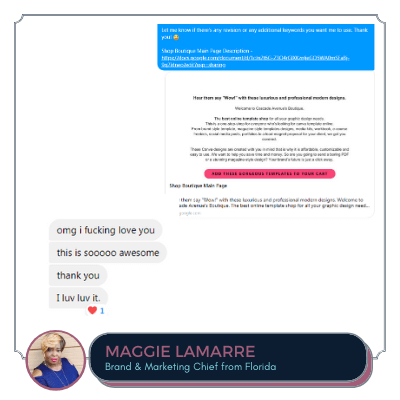Content writing is different from copywriting.
The only difference is it’s purpose. Content writing provides information, while copywriting sells.
I created a separate case study on some of my content writing gigs for website, ebook content creation and ghostwriting.
In this case study, I’d like to talk about copywriting. The two projects are website and email copywriting. Copywriting is writing to sell.
Here's what you will learn:
Project Background:
The client sells digital products like Canva templates, brand style templates, magazine-style template designs, media kits, workbooks, social media posts, portfolios to a lead-magnet proposal for your client. It’s a one-stop shop for everyone who’s looking for Canva templates online.
Project 1 – The first project is for her digital store. She wants me to write a copy for her landing page. I need to come-up with a web copy that entice her clients to buy her designs.
Project 2 – The second project is with the same client. It’s an email nurturing campaign for her friend. It’s a different medical niche. They created the site to provide knowledge to CLL patients and their caregivers.
Basic Tips on Copywriting
I list scientifically backed copywriting tips; if you want to read the in-depth research, please check the description below. I’ll leave a link there.
- Hook + Emotions – Nobody wants to read long-ass text. Keep your sentences short. The hook should be a one-liner punch that targets their emotions. Let them know the problem. Make them feel something.
- Be authentic – The Internet is too noisy. And your authenticity will make you stand out from the crowd. Your story is your selling point. What makes you unique? What makes the product different from the competitor?
- Detailed Imagery – Probably, you’ve read something like “Imagine yourself living the good life…” or “Picture this, you’re driving, and you can see the beautiful sunset on the horizon.”
- Suspense – Adding that element of uncertainty will keep your readers glued to your content. Keep your sentences short. It’s easier to understand and has that element of suspense. What’s next? See more? Read more.
- You can also add metaphors, irony, and other figures of speech.
You don’t have to memorize everything. Just remember this formula – PAPA, which stands for Problem, Advantages, Proof, Action.
Problem
Always start with a problem, especially if you’re writing to cold audiences. Your problem statement should be relatable enough to catch their attention; if you could hit their emotions, the better.
Advantages
After stating the problem, slowly transition and offer your product and services. You can enumerate at least three advantages or benefits. Here comes, “what’s in it for me?” part.
Proof
Do you have proof that what you offer works? If yes, then show it. Our digital clients are skeptical about purchasing online. The scammers and “fake-gurus” are lurking everywhere.
Action
Make your call-to-action visible and easy to access. We have a short attention span. So always end your copywriting with clear instruction of what’s next.
Client Testimonial


